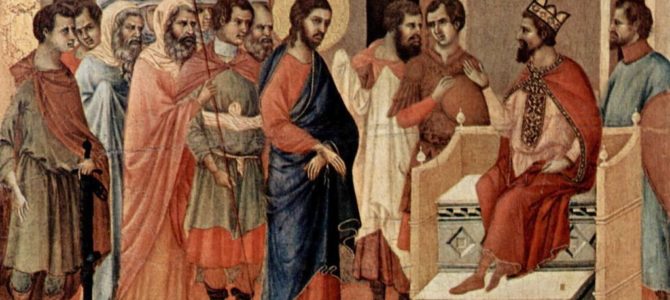
The birth of Christ has long been a parlor game among historians, at least those who accept the Matthew and Luke nativity narratives as having any historical saliency. This often includes conjecture over the Star of Bethlehem, nowadays assumed to have been one of many planetary conjunctions in the late first century BC, or an otherwise unrecorded supernova.
Unlike the crucifixion, which can be anchored to Passover dates, Christmas lacks an unambiguous scheduling mainstay on the calendar, and provides only tenuous references to the year of the heralded birth. The paucity of records during that period on the Roman Empire’s frontier raises doubts about the census described in Luke’s second chapter. The only reference commonly adopted remains the death of Herod the Great, and even the year of its occurrence engenders controversy.
Relatively few ancient dates can be determined with specificity on the Julian calendar, such as the Battle of Actium on 2 September 31 BC or 723 AUC (Ab urbe condita) in the Ionian Sea; the death of Augustus on 19 August AD 14 or 767 AUC in Nola Italy; and the death of Tiberius on 16 March AD 37 or 790 AUC in Miseno Italy.
Both nativity accounts in Matthew and Luke emphasize Bethlehem of Judea, while Mark 1:9 and John 1:46 and 7:41-42 suggest Nazareth in Galilee for the messiah’s origin. In particular, Matthew 2:1 declares that Jesus of Nazareth was born in Bethlehem during the reign of Herod the Great. Verses 14-22 reveal that Jesus’ family escaped Judea and stayed in Egypt until Herod died.
Luke 1:5 dates the nativity stories to the time of Herod, but then Luke 2:1-2 associates the birth of Jesus with a census when Quirinius was governor of Syria. The gospel accounts are difficult to reconcile, especially in view of purported chronologies available for Roman officials and their edicts.
Complications from Differing Contemporary Accounts
Based on accounts by Josephus in “Antiquities of the Jews” available in “Collected Works,” historians since Emil Schürer (nineteenth century) correlate Herod’s death as 37 years after Rome bestowed kingship (Ant. 17.191). The year has been pegged to a preceding partial lunar eclipse on 13 March 4 BC or AUC 750 (Julian calendar), which coincided with the execution of two rabbis for desecrating an eagle icon.
However, as Jack Finegan reported in “Handbook of Biblical Chronology,” most early Christian authors ascribe the birth of Jesus to the 41st year of Augustus from late 3 BC to early 2 BC, including Irenaeus, Tertullian, Julius Africanus, Origen, Eusebius, and Epiphanius. Clement of Alexandria declared precisely that Christ’s birth preceded the murder of emperor Commodus on 31 December AD 192 by 194 years, one month and 13 days, corresponding to Monday 18 November 3 BC, or 11 Kislev AM 3759 (Anno Mundi) by the Church of God Study Forum calendar converter. Under these schemes, the traditional dates for Herod’s death and the birth of Jesus cannot be reconciled with the Matthean account.
A further complication involves the taxation census and the career of Quirinius. Acts 5:37 mentions a revolt by Judas of Gamala in response to a census. Josephus describes Judas’ uprising (War 2.433 and Ant. 18.4-8). Publius Sulpicius Quirinius was named consul in 12 BC and afterwards campaigned in central Anatolia until 1 BC before being appointed rector to Augustus’ grandson Gaius Caesar, who died in AD 4.
Following the exile of Herod Archelaus in AD 6, the Romans directly administered Judaea (including Samaria and Idumea). Quirinius was appointed Legate of Syria in Damascus from AD 6-12 with authority to assess Judaea for taxes.
Josephus (Ant. 18.26) states Cyrenius (i.e., Quirinius) conducted the census in the 37th year after Actium (ad 6-7) after the inability of High Priest Joazar Boethus to quell rebellion. Any earlier unrecorded census would presumably have been conducted by Herod the Great, without assistance from a neighboring governor.
Thus, the Lucan nativity account offers AD 6 as the year of Jesus’s birth, which fails to conform to the observation in Luke 3:23 that Jesus was about 30 years old upon beginning his ministry (in presumed conformance with Numbers 4:3) reported in Luke 3:1 as during Tiberius’ 15th year following August or September AD 29. John 7:10-14 begins Jesus’ introduction at the temple midway during Sukkot or the Festival of Tabernacles (about Wednesday 23 Tishri AM 3790 = 19 October AD 29). This later public entry is more reliable than a birth announcement due to broader witness.
Interestingly John Rhodes defends the Lucan chronology by observing ostensibly duplicated accounts. Rhodes proposes that the eagle revolt leader Judas (War 1.648) whom Herod quashed was the same man (Ant. 18.23) who rebelled against the tax assessment.
Rhodes conflates Quirinius and Sabinus as the same legate in Syria, and further reports (Ant. 17.134) Coponius, the first prefect of Judea following Archelaus, being present in Jerusalem during Antipater’s trial in 5 BC. Even if the latter uprising might be datable to Herod’s reign, associating this event with the Lucan census necessitates that Josephus’ accounts include readily confirmable numerical errors regarding its post-Actium year counting. Such assumptions would be speculative.
But Josephus Didn’t Always Get Dates Right
Recent scholarship by Andrew Steinmann seeks to resolve this discrepancy by comparing Josephus’ accounts with other ancient sources and astronomical determination. Steinmann observes that Josephus errs slightly in some cross-correlations, such as Herod’s royal acceptance by the Senate (Ant. 14.388-389) that incorrectly identifies either the Olympiad or the consuls. Steinmann concludes that Herod’s appointment came in 39 BC. Thirty-seven years from this date extends Herod’s life beyond 4 BC.
An earlier study by W. E. Filmer supports this view, citing Jewish tradition that Herod passed away shortly after either the 7 Kislev or 2 Shevat holidays, and further comments on Josephus’s chronological deviations from other ancient records. Also, Josephus (Ant. 18.106) dates the death of Philip, who reigned over Iturea and Trachonitis 37 years, in the twentieth year of Tiberius. By contrast, Filmer contends that early manuscripts correct this to the 22nd year, thus beginning Philip’s reign in 1 BC rather than three years earlier.
Additional details from Josephus support this later chronology for Herod. For instigating the destruction of a golden eagle over the Temple gate (Ant. 17.151), Judas and Matthias were brought to Jericho (Ant. 17.160) for trial during a fast observance (Ant. 17.165). The two rabbis were burned alive the night before a lunar eclipse (Ant. 17.167). Tony Freeth elucidates the ability of ancient astronomers to predict lunar eclipses, as demonstrated by the Antikythera mechanism discovered in 1901.
So There Were a Bunch of Eclipses During This Period
Candidates for this general period over Judea include total eclipses on 23 March 5 BC, 15 September 5 BC, and 10 January 1 BC, and partial eclipses on 13 March 4 BC and 29 December 1 BC. All these eclipses only partially shadowed the moon from Judea. These Julian dates can be narrowed further by specifics concerning Herod’s death and funeral prior to the Feast of Unleavened Bread (Ant. 17.239) immediately following Passover.
Herod’s illness necessitated crossing the Jordan River (Ant. 17.171) for mineral waters then returning to Jericho. Herod ordered Jewish elders to be placed in custody (Ant. 17.178) and received authorization from Rome (Ant. 17.182) to execute his son Antipater (Ant. 17.187) for the murder of Herod’s brother Pheroras. Herod died five days later (Ant. 17.191).
Medical observation and treatment could involve two weeks, and the royal funeral procession (Ant. 17.196-200) would necessitate almost a month. Steinmann explains that the 29-day interval between the traditional 13 March 4 BC eclipse and Passover (Wednesday 14 Nisan AM 3757 = 11 April 4 BC) would be inadequate for all these events. Moreover, as Ernest Martin postulated, executing rabbis during the celebration of Purim following the fast of Esther (Monday 13 veAdar AM 3757 = 12 March 4 BC) could incite riots among the population.
The Megillath Taanith (Scroll of Fasting) from the first century includes the fast of Asarah beTevet (the tenth of Tevet). This was commemorated for the trial date (Tuesday 10 Tevet AM 3760 = 6 January 1 BC) five days before the lunar eclipse that marked the rabbis’ executions. The interval from the 10 January 1 BC total eclipse to the Passover (Wednesday 14 Nisan AM 3760 = 7 April 1 BC) would be an ample three months for royal funerary arrangements.
In addition, nineteenth-century linguist Moïse Schwab concluded that the date of Herod’s death was commemorated on the second of Shevat (Tuesday 2 Shevat AM 3760 = 27 January 1 BC). The 29 December 1 BC partial eclipse also satisfies the preparatory interval while having limited occlusion from the Ancient Near East, but James Nollet argues in its favor.
Despite Disagreement, the Dates Can Work
This conclusion is not universally accepted. P. M. Bernegger defends the traditional date against Filmer, arguing that Josephus did not consistently employ the ascension method of regnal years used modernly, and frequently reckoned inclusively (i.e., counting as an entire year the interim period after throne succession until the next calendar cycle). Thus Bernegger dismisses discrepancies between consular lists and years following an event (e.g., Actium) as a basis of date revision. Raymond Jachowski also remains skeptical, concluding that the Matthean and Lucan accounts cannot be reconciled.
Nonetheless, the balance of recent scholarship that presents Herod’s passing early (probably late January) in the Roman year AUC 753 and by our reckoning 1 BC before the new era is indeed consistent with early Christian writings regarding the messiah’s birth. Such details may seem pointlessly trivial to the spiritually devout, and irrelevant to non-believers. However, such information helps establish the historical context of religiously significant events. The search for this background can strengthen the faith of Christians interested in the limited secular evidence available.









